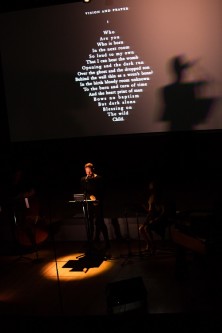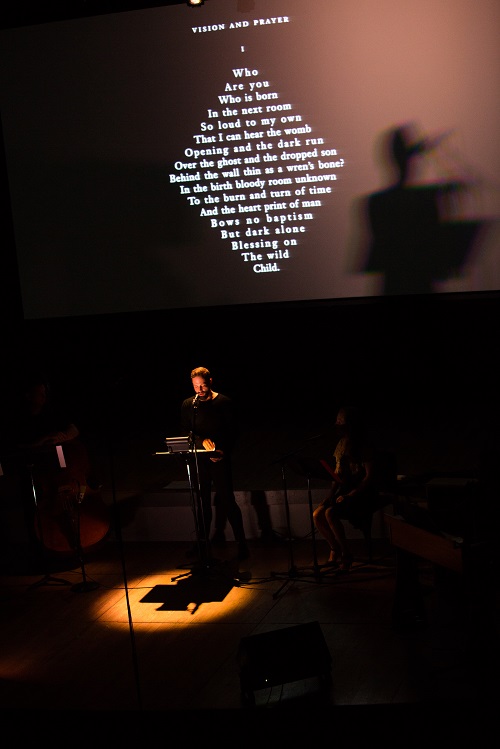 United States Resonant Bodies Festival, Concerts I and II: Soloists, Roulette, New York City. 6-7.9.2016. (BH)
United States Resonant Bodies Festival, Concerts I and II: Soloists, Roulette, New York City. 6-7.9.2016. (BH)

Concert I – Julia Bullock, Alice Teyssier & Sofia Jernberg
Concert II – Abigail Fischer, Peter Tantsits & Dashon Burton
Billed as “the world’s only contemporary vocal music festival,” Resonant Bodies fulfills an implicit promise to wow and intrigue, by booking some of the planet’s most creative vocalists and then cutting them loose—each curating a 45-minute set. In the first two (of three) nights at Roulette, the vocalists produced results that went far beyond tonal beauty, though there was much of that on display.
If only those who bemoan John Cage could have heard Julia Bullock open the festival with She Is Asleep (1943), a disarming valentine, with Milena Gligic at a piano altered to create piquant, thudding counterpoint. Inspired by the poetry of Wallace Stevens, Bullock completed her set with David Hertzberg’s Ablutions of Oblivion (2013), with nods to Messiaen in the piano chords, and Lukas Foss’s classic Thirteen Ways of Looking at a Blackbird (1978). In the latter, Bullock’s honeyed tone blossomed among the shimmering percussion helmed by Amy Garapic, and Fanya Wyrick-Flax’s bursts of flute color.
Drawing on influences from the 18th century and juxtaposing them with a formidable work from the 20th, Peter Tantsits created a subtly provocative landscape, in a single arc spanning old and new with the sepia glow of time’s erosion. With a transparent continuo of harp (Nuiko Wadden), double bass (Tony Flynt), and ondes martenot (Suzanne Farrin), Tantsits effortlessly traversed through William Croft and Henry Purcell to Anna Thorvaldsdottír and Pascal Dusapin. A subtle tribute from Gerald Barry—Karlheinz Stockhausen 1927-2007—used a probing, 1821 letter from Beethoven as its text. And in the dazzling centerpiece, the adventurous tenor launched into Milton Babbitt’s Vision and Prayer (1961) with electronics supervised by Nathan Davis.
Like Tantsits, other singers offered sets conceived as an unbroken line. Abigail Fischer, barefoot and dressed in a white gown, roamed across territory for voice and electronics mapped by Lewis Pesacov, Kevin McFarland, Nigel Deane, and Shane Monds, as if summoning listeners into a secret, hypnotic chamber. Her mesmerizing opening was No (2007), a ritualistic drone by Caleb Burhans. Of the visual elements projected onscreen, the most effective accompanied Missy Mazzoli’s I am Not Mine (2012), with an unsettling black-and-white film worthy of David Lynch.
Alice Teyssier, with the adroit help of Bradley Scott Rosen on electronics and vocalist Michael Weyandt (collectively known as The Atelier) unveiled the world premiere of The Grand Cross, inspired by an astrological phenomenon implying “tension and instability.” Four video monitors added a frisson of artist Nam June Paik, as Teyssier offered unusually fluid work. A Villa-Lobos excerpt combined lyricism amid Rosen’s sculpted, subterranean rumbles, augmented by electric guitar. Casually seated at a small table, Weyandt poured speech into the mix. In the solo epilogue, Teyssier’s power was magnified as all lights were extinguished.
Two singers offered even rawer, more experimental visions. From Sweden, Sofia Jernberg deployed her voice in an unusually varied palette. An Ethiopian folk song on one side, and Johan Jutterström’s Kyrka, Kyrka [Church, Church] on the other, surrounded the fluttering whir of Jernberg’s One Pitch: Birds for Distortion and Mouth Synthesizers (2015). The latter was a delight, filled with intakes of breath close to a microphone, bleating on a single note, and a gutteral texture that evoked electronic feedback, or tapes played backward at high speed. If one’s gaze drifted away from her—virtually impossible—it would be difficult to parse the source of some of the sounds.
Dashon Burton had the pleasure of ending the second night, and demonstrated his prowess with electronics. A founding member of Roomful of Teeth, Burton’s scope ranges from the folk song simplicity of works by David Hurd and Jake Endres, to the hallucinatory world of Georges Aperghis and “Gemini” from Stockhausen’s Tierkreis—all with the singer standing, navigating a laptop to alter his timbres. In between came the world premiere of Burton’s Light Year, handsomely showing off his deep tone against bubbling ostinatos and siren-like rising and falling glissandos.
Jane Sheldon, a singer from Australia who performed at Resonant Bodies in 2014, announced that the festival will have an Australian counterpart in 2017. It is a testament to the vision, tenacity, and wide-ranging curiosity of the festival’s founder, singer Lucy Deghrae, who has created what Sheldon called “a vocal utopia.”
Bruce Hodges
